

Croix de Guerre 14/18. Accueil - Apocalypse 10 destins. 151st Line Infantry Regiment. Tobacco use at the time of the Great War was extremely popular in all European male societies, across all classes and professions.
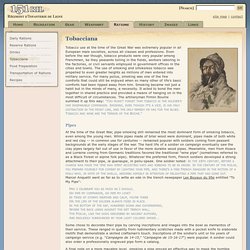
Even before the war though, tobacco products were very popular among Frenchmen, be they peasants toiling in the fields, workers laboring in the factories, or civil servants employed in government offices in the cities and towns. The use of smoking and smokeless tobacco was propelled to even greater heights as millions of men entered into military service. For many poilus, smoking was one of the few comforts that could still be enjoyed when so many other of life's basic comforts had been ripped away from him. Smoking became not just a habit but in the minds of many, a necessity. It acted to bond the men together in shared practice and provided a means of hanging on in the most difficult of circumstances. Pipes At the time of the Great War, pipe-smoking still remained the most dominant form of smoking tobacco, even among the young men. Tobacco Ration Cigarettes. Presentation. La première guerre mondiale vue à travers la publicité.
L'Aisne au coeur de la Grande Guerre. Expo 14, Visages et Vestiges de la Grande Guerre. La Grande Guerre de part et d'autre - Ailleurs. 1914 - 1918 (245) 1a.jpg (1539×1605) Fields of Battle 1914-1918, Lands of Peace 2014-2018. Fields of Battle 1914-1918, Lands of Peace 2014-2018, is a registered charity which has developed a touring street gallery exhibition "based not on the horrors of war, but on how over time, nature has healed the battlefields".

The exhibition will tour the United Kingdom from August 2014 until Armistice Day (11th November) 2018. The exhibition, which is free to the public, features 66 large-scale (1.8 x 1.2 metre) colour photographs of the battlefields as they are now, with accompanying caption panels detailing the historic significance of the main image together with "thought-provoking learning points". The exhibition also features a giant walk-on map, with an enlarged European section, "which offers visitors the opportunity to walk from country to country to appreciate the scale and complexities of the conflict. The map puts Europe in context on a global scale, in terms of personnel and resources, together with providing engaging details on key battlefield locations" Compter les vivants et les morts : l'évaluation des pertes françaises de 1914-1918.
Notes Professeur émérite d’histoire contemporaine à l’Université Paris I.
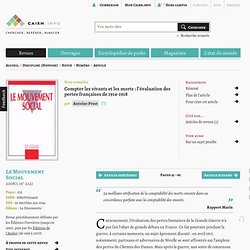
L. Marin a rédigé trois rapports, qui se recopient partiellement : Rapport fait au nom de la Commission du Budget…, Journal Officiel, Documents parlementaires de la Chambre des députés, 1919, annexe n° 6 235, p. 1708-1720 ; Rapport supplémentaire…, ibid., 1919, annexe n° 6 659, p. 2317-2331 ; Proposition de résolution tendant à charger la Commission de l’Armée de faire connaître le bilan des pertes en morts et en blessés des nations belligérantes…, ibid., 1920, annexe n° 633, p. 32-78.
C’est ce dernier texte, édité en brochure autonome, que l’on désigne généralement sous le nom de « rapport Marin ». Un exemplaire, amputé de ses dernières pages, se trouve dans les archives Marin, Archives Nationales (AN), 317 AP 129. M. War Days : un album sur Flickr. Actualites de l'histoire. Hawthorn Ridge Mine – The German experience, Somme, 1st of July 1916.
The account below is a translated extract from the regimental history of Infanterie-Regiment No. 119, which was published in 1920 and based on the regimental war diary kept by the Reichsarchiv in Potsdam.

Written and compiled by former officers of the regiment, it contains a fascinating account on the fighting that took place on the first of July 1916. The regiment itself being the one affected by the explosion of the Hawthorn Ridge Mine. IR119, subordinated to 26th Reserve Division, spent World War I on the Western Front. It fought in the Battle of the Frontiers and then participated in the Race to the Sea, fighting in the Somme region. It occupied the line in the Somme/Artois region into 1916, facing the British offensive in the Battle of the Somme. In 1917, it fought in the Battle of Arras. This post is dedicated to the 8355 men of the Regiment who were killed or wounded in World War 1. Soldiers of IR119 in May 1915.
Hawthorn Ridge Mine – The German experience, Somme, 1st of July 1916. Mémoire et histoire - Commémoration du Centenaire de la Première Guerre mondiale. Une grande commémoration nationale Les enjeux La commémoration du centenaire de la Première Guerre mondiale est porteuse de plusieurs enjeux mémoriaux importants : la compréhension d'une épreuve qui engagea l'ensemble de la société française ;la transmission de cette mémoire aux Français d'aujourd'hui ;l'hommage rendu à ceux qui vécurent la guerre et firent le sacrifice de leur vie ;l'appréhension du conflit dans la perspective d'une histoire nationale et européenne partagée.

Cent ans après ce terrible conflit, il s'agit pour les Etats européens d'être porteurs d'un message de paix, afin de contribuer à la construction d'un avenir commun. Guerre et société 4/4 - Histoire. Le dossier GUERRE 1914-1918 Page 1. La Première guerre mondiale expliquée aux enfants. La représentation du soldat durant la Grande Guerre. L’histoire culturelle de la Grande Guerre apparaît comme indissociable de la question nationale.

La mobilisation des armées au cours de l’été 1914 définit pour la première fois l’affrontement sur les bases de la conscription universelle et sa réussite, nous dit l’historien Jean-Jacques Becker, doit être regardée comme le résultat mécanique du triomphe de l’idée nationale . Le cas britannique de recours au volontariat comme celui des Dominions sont emblématiques de ce point de vue en raison du succès massif que rencontrèrent les campagnes de recrutement.
C’est en relation avec ce contexte inédit de guerre nationale fondée sur la mobilisation générale qu’a été conçu ce dossier sur le soldat de 14-18 dans les représentations des sociétés en guerre. Le conflit européen se révèle en effet d’abord comme un affrontement entre nations. Le phénomène s’est trouvé amplifié par la lecture et l’interprétation fondamentalement défensive du conflit chez tous les protagonistes. La Grande Guerre en dessins, des artistes pendant la premiere guerre mondiale 14-18. Experience World War I through a German officer's photos by Dean Putney. I have a real book in my hands now!
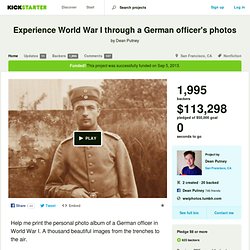
Thank you all so much! If you're in the San Francisco area, please join me in celebrating the completion of funding this evening! See the collection as I scan it on Tumblr More information at WalterKoessler.com. Unseen World War I photos: German Trenches. The following photos were taken from 1914-1918 by my great-grandfather Lt.

Walter Koessler during his time as a German officer in the first World War. They're part of a collection of over a thousand photos, stereographs and their negatives that my family has been saving for a century. This is an unusually large and complete collection, and I've taken on the task of preserving it and printing it so other people can experience this history too. These photos have never been published before. Walter's trenches were very well built, but they still couldn't keep out the snow and the rain. Playing cards next to the garden. World War One from a German soldier's perspective: Hundreds of images give a rare insight into the side of the Great War we rarely see. Walter Koessler took almost 1,000 images while he served in the German Army during the war The images have been perfectly preserved by his descendants in America but were unseen by public Walter's great-grandson Dean Putney has shared them and hopes they 'humanize the war' Is fundraising to turn the unique collection into a photo book in time for next year's 100th anniversary By Becky Evans Published: 16:35 GMT, 8 August 2013 | Updated: 23:08 GMT, 8 August 2013 Hundreds of rare images charting one German soldier's experiences of the First World War have been made public for the first time.
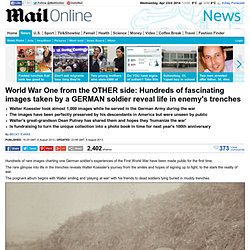
The rare glimpse into life in the trenches reveals Walter Koessler's journey from the smiles and hopes of signing up to fight, to the stark the reality of war. Recherche avancée 4-VM7-208 - 198 résultats sur Gallica - Tri par date de mise en ligne décroissante. 1914-1918 : première Guerre mondiale par la photographie. Les origines de la guerre. ALBUM N°1. ALBUM N. ALBUM N. ALBUM N. PREMIERE GUERRE MONDIALE. Manuel : "Histoire-géographie 3è", Hâtier, Avril 2003.
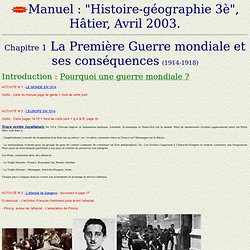
Chapitre 1 La Première Guerre mondiale et ses conséquences (1914-1918) Introduction : Pourquoi une guerre mondiale ? Outils : carte du manuel page de garde + fond de carte joint Outils : Carte pages 14-15 + fond de carte joint + § A & B, page 16. Trace écrite (synthèse): En 1914, l’Europe impose sa domination politique, coloniale, économique et financière sur le monde. . . Première guerre mondiale, gouvernement, guerre, Photographie, Arthur Mole, John D. Thomas, Philadelphie, oncle sam, Dossier pédagogique : La Première Guerre Mondiale. Guerre de 14-18.
Les emprunts nationaux de 1916 et 1917. Contexte historique. La Grande Guerre en dessins, des artistes pendant la premiere guerre mondiale 14-18.